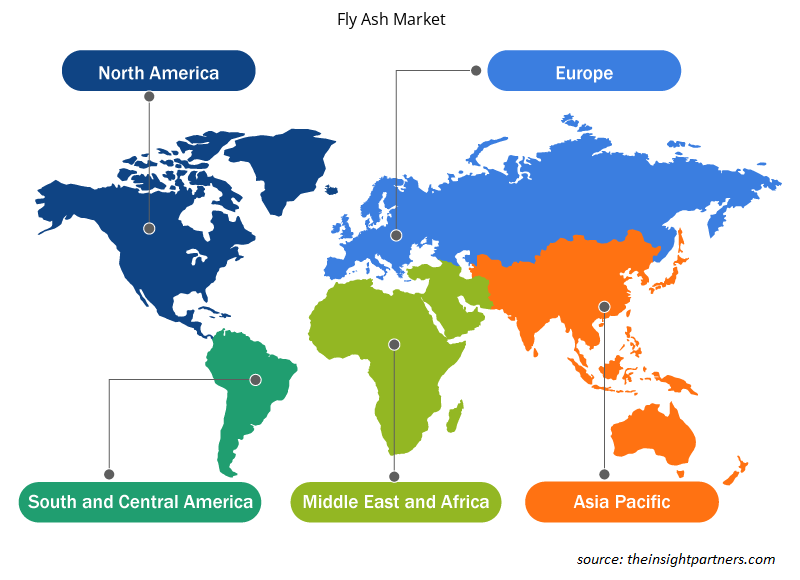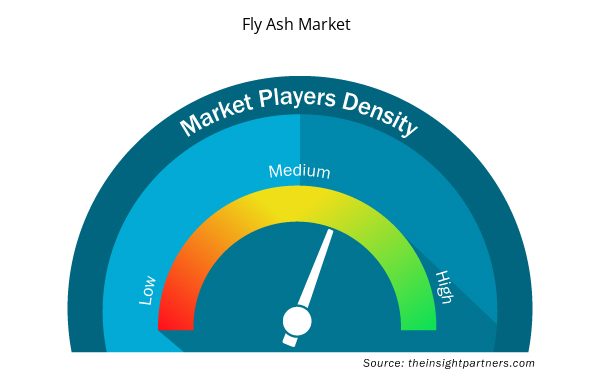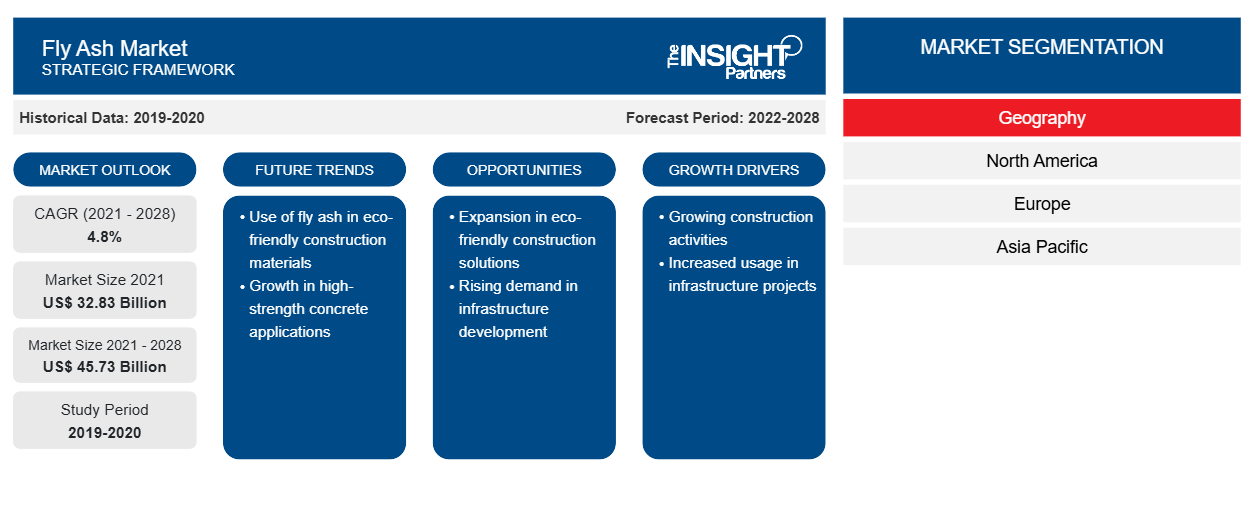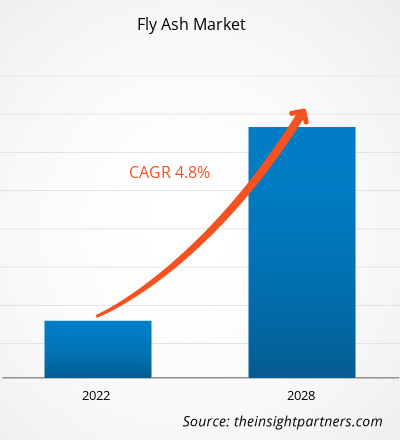[研究报告] 2021年粉煤灰市场价值为328.3亿美元,预计到2028年将达到457.3亿美元;预计2021年至2028年复合年增长率为4.8%。
市场分析
粉煤灰是燃烧产生的残余物,含有二氧化硅、氧化铝、氧化铁等细小颗粒,有时还含有氧化钙。它是一种细小的灰色粉末,具有火山灰性质,可与石灰反应形成水泥化合物。它们用途广泛,例如水泥和混凝土混合、矿山和水坝、垃圾填埋场、土聚物混凝土等。它可改善混凝土在混合时的性能,还可作为热解过程中转化聚乙烯的催化剂。
增长动力与挑战
建筑业的持续增长显著推动了全球粉煤灰市场的增长。美国、中国、印度等亚太国家拥有世界上最大的建筑规模。高建筑活动率对各种建筑材料产生了巨大的需求。粉煤灰用于多种建筑专用应用,如水泥、混凝土、砖块和砌块。粉煤灰在建筑行业的各种应用中的使用越来越多。此外,粉煤灰在各种应用中的使用越来越多,进一步推动了全球粉煤灰市场的增长。粉煤灰用于各种应用,如水泥和混凝土、砌块和砖块、采矿、填料和路堤等。由于其火山灰特性,在混凝土中使用粉煤灰非常有益,因为它可以提高混凝土的耐久性。在波特兰水泥混凝土的制造中,粉煤灰被用作辅助胶凝材料 ( SCM ) 来提高这种混凝土的性能。粉煤灰砖被用作建筑材料来代替粘土砖。与传统粘土砖相比,粉煤灰砖更轻、更坚固、成本低、不需要灰泥,并且有助于减少建筑费用和土壤侵蚀。然而,对粉煤灰的好处或潜在用途缺乏认识可能会限制其市场增长。粉煤灰是多种应用的重要原料。然而,人们对粉煤灰及其衍生物的化学性质缺乏了解,无法将其用于适当的最终应用。公众对产品缺乏认识是粉煤灰利用率低的原因之一。
定制此报告以满足您的需求
您可以免费定制任何报告,包括本报告的部分内容、国家级分析、Excel 数据包,以及为初创企业和大学提供优惠和折扣
- 获取此报告的关键市场趋势。这个免费样品将包括数据分析,从市场趋势到估计和预测。
报告分类和范围
“2030 年全球粉煤灰市场分析”是一项专业而深入的研究,主要关注全球粉煤灰市场趋势和增长机会。该报告旨在概述全球粉煤灰市场,并按类型、应用和地域对市场进行详细细分。全球粉煤灰市场近年来一直呈现高增长,预计在预测期内将继续保持这一趋势。该报告提供了全球粉煤灰消费量的关键统计数据以及主要地区和国家的需求。此外,该报告还对影响主要地区和国家粉煤灰市场表现的各种因素进行了定性评估。该报告还包括对粉煤灰市场主要参与者及其关键战略发展的全面分析。还包括对市场动态的几项分析,以帮助确定关键驱动因素、市场趋势和有利可图的粉煤灰市场机会,进而有助于确定主要收入来源。
此外,生态系统分析和波特五力分析提供了全球粉煤灰市场的360度视角,有助于了解整个供应链和影响市场增长的各种因素。
节段分析
全球粉煤灰市场根据类型和应用进行细分。根据类型,粉煤灰市场分为 C 型和 F 型。根据应用,市场分为水泥和混凝土、砌块和砖块、采矿、道路稳定、填料和路堤、废物稳定等。根据类型,C 型部分占据了粉煤灰的大部分市场份额,这可以归因于粉煤灰在各种应用中的使用越来越多。C 型粉煤灰通常来自亚烟煤和褐煤。C 型粉煤灰独特的自硬化性能归因于其高生石灰 (CaO) 浓度。C 型粉煤灰最适合性能混合物、预应力应用和其他需要更高早期强度的应用。由于 C 型粉煤灰的石灰含量高,它在土壤稳定方面非常有效。根据应用,水泥和混凝土部分占据了粉煤灰的主要市场份额,这可以归因于建筑行业对粉煤灰的采用日益增加。粉煤灰被用作制造波特兰水泥混凝土的辅助胶凝材料 (SCM)。与具有相同可加工性的波特兰水泥混凝土相比,使用细度高、碳含量低的优质粉煤灰可降低混凝土的需水量。因此,粉煤灰应允许以较低的含水量生产混凝土。这将进一步为整个行业增长带来新的增长机会。
区域分析
报告详细介绍了全球粉煤灰市场在五个主要地区的概况,即北美、欧洲、亚太地区 (APAC)、中东和非洲 (MEA) 以及南美和中美。中东和非洲占据了相当大的市场份额,2022 年价值超过 6 亿美元,预计到 2030 年将达到约 10 亿美元。建筑活动的快速增长,尤其是在中东,为中东和非洲的市场增长做出了积极贡献。亚太地区预计也将在 2022 年实现价值超过 250 亿美元的可观增长,这归因于该地区在各种应用中粉煤灰的使用增加,推动了全球粉煤灰市场的增长。北美预计也将在 2022 年实现价值超过 40 亿美元的可观增长,这归因于建筑行业对粉煤灰的使用增加,预计将推动全球粉煤灰市场的增长。
行业发展和未来机遇
合作、收购和新产品推出被发现是全球粉煤灰市场参与者所采用的主要策略。
- 2021年11月,美国拉法基豪瑞(LafargeHolcim)、Geocycle和CenterPoint Energy将回收垃圾填埋场中的发电厂煤灰,用于水泥制造。
- 2021 年 9 月,Charah Solutions 荣获为期 5 年的粉煤灰销售和营销合同,用于俄亥俄州加文发电厂生产粉煤灰的有效利用。
新冠疫情的影响/地缘政治形势的影响/经济衰退的影响
COVID-19 疫情导致全球许多行业的发展放缓。全球制造工厂的关闭和贸易限制导致全球制造商的供应链受限。持续的疫情彻底改变了化学品和材料行业的现状,并对粉煤灰市场的增长产生了负面影响。为防止病毒传播而采取的措施加剧了这种情况,并影响了多个工业部门的增长。许多火电厂没有运行或以较低的产能运行。这对粉煤灰的产生和利用产生了负面影响。这场疫情造成了一场全球健康危机,扰乱了包括建筑业在内的所有行业。经济活动减少导致对新商业或工业设施的需求减少。收入损失和消费者信心不足对住房建设的需求产生了负面影响。此外,建筑工地还面临供应链中断和运营限制。然而,随着各经济体计划恢复运营,全球对粉煤灰的需求预计将上升。因此,粉煤灰市场从疫情的余波中恢复得相当好,预计未来几年还会增长。
粉煤灰市场区域洞察
Insight Partners 的分析师已详细解释了预测期内影响粉煤灰市场的区域趋势和因素。本节还讨论了北美、欧洲、亚太地区、中东和非洲以及南美和中美洲的粉煤灰市场细分和地理位置。

- 获取粉煤灰市场的区域具体数据
粉煤灰市场报告范围
| 报告属性 | 细节 |
|---|---|
| 2021 年市场规模 | 328.3亿美元 |
| 2028 年市场规模 | 457.3亿美元 |
| 全球复合年增长率(2021 - 2028) | 4.8% |
| 史料 | 2019-2020 |
| 预测期 | 2022-2028 |
| 覆盖地区和国家 | 北美
|
| 市场领导者和主要公司简介 |
|
市场参与者密度:了解其对商业动态的影响
粉煤灰市场正在快速增长,这得益于终端用户需求的不断增长,而这些需求又源于消费者偏好的不断变化、技术进步以及对产品优势的认识不断提高等因素。随着需求的增加,企业正在扩大其产品范围,进行创新以满足消费者的需求,并利用新兴趋势,从而进一步推动市场增长。
市场参与者密度是指在特定市场或行业内运营的企业或公司的分布情况。它表明在给定市场空间中,相对于其规模或总市场价值,有多少竞争对手(市场参与者)存在。
在粉煤灰市场运营的主要公司有:
- 博拉尔
- 西麦斯南非公司
- 豪瑞姆
- 废物管理公司
- Charah Solutions, Inc.
免责声明:上面列出的公司没有按照任何特定顺序排列。

- 获取粉煤灰市场顶级关键参与者概述
竞争格局和主要公司
粉煤灰市场的一些主要参与者包括 Boral LTD.、Cemex SAB DE CV、Lafargeholcim Ltd.、Waste Management, Inc.、Charah, LLC、Separation Technologies LLC、Cement Australia PTY Limited、Salt River Materials Group、Ashtech India Pvt. Ltd. 和 Duromar, Inc. 等。
- 历史分析(2 年)、基准年、预测(7 年)及复合年增长率
- PEST 和 SWOT 分析
- 市场规模价值/数量 - 全球、区域、国家
- 行业和竞争格局
- Excel 数据集



Report Coverage
Revenue forecast, Company Analysis, Industry landscape, Growth factors, and Trends

Segment Covered
This text is related
to segments covered.

Regional Scope
North America, Europe, Asia Pacific, Middle East & Africa, South & Central America

Country Scope
This text is related
to country scope.
常见问题
The cement and concrete segment is the fastest growing segment in the global fly ash market during the forecasted period. The rapid popularity of using fly ash in concrete to achieve high-performance and strength is one of the crucial factors driving the market for the cement and concrete segment.
Asia Pacific is estimated to register the fastest CAGR in the global fly ash market over the forecast period. The growth of the fly ash market in Asia-Pacific is driven by rising government infrastructural development projects and increasing utilization of fly ash-based concrete for the construction of new infrastructures in the region.
The type C fly ash segment held the largest share of the global fly ash market in 2021. Type C fly ash is often obtained from sub-bituminous and lignite coal. Type C fly ash's distinctive self-hardening properties are due to its high quicklime (CaO) concentration. Type C fly ash is best for performance blends, pre-stressed applications, and other applications that require greater early strengths.
In 2021, Asia Pacific held the largest share of the global fly ash market. The market growth in this region is attributed to increasing infrastructural developments, such as the development of rail networks, fly overs, and highways; rising activities in residential and commercial construction; and high emphasis of governments and other regulatory bodies on recycling and reutilizing fly ash. Governments in countries such as India, China, and Japan have taken various initiatives to save energy and avoid dumping fly ash into landfills and ponds, resulting in the increased use of fly ash in concrete and Portland cement.
The major players operating in the global fly ash market are Boral; CEMEX S.A.B. DE C.V.; HOLCIM; Waste Management, Inc.; Charah Solutions, Inc.; Salt River Materials Group; Cement Australia Pty Limited; Ashtech India Pvt. Ltd.; Titan America, LLC.; Aceton Industries, LLP; among others.
The cement and concrete segment held the largest share of the market in 2021. Fly ash is used as a supplementary cementitious material (SCM) to manufacture Portland cement concrete. Compared to Portland cement concrete of the same workability, the use of excellent-quality fly ash with high fineness and low carbon content reduces the water demand of concrete. Moreover, the heat of hydration of concrete can be reduced by replacing cement with the same quantity of fly ash.
Trends and growth analysis reports related to Chemicals and Materials : READ MORE..
The List of Companies - Fly Ash Market
- Boral
- CEMEX S.A.B. DE C.V.
- HOLCIM
- Waste Management, Inc.
- Charah Solutions, Inc.
- Salt River Materials Group
- Cement Australia Pty Limited
- Ashtech India Pvt. Ltd
- Titan America, LLC.
- Aceton Industries, LLP
The Insight Partners performs research in 4 major stages: Data Collection & Secondary Research, Primary Research, Data Analysis and Data Triangulation & Final Review.
- Data Collection and Secondary Research:
As a market research and consulting firm operating from a decade, we have published and advised several client across the globe. First step for any study will start with an assessment of currently available data and insights from existing reports. Further, historical and current market information is collected from Investor Presentations, Annual Reports, SEC Filings, etc., and other information related to company’s performance and market positioning are gathered from Paid Databases (Factiva, Hoovers, and Reuters) and various other publications available in public domain.
Several associations trade associates, technical forums, institutes, societies and organization are accessed to gain technical as well as market related insights through their publications such as research papers, blogs and press releases related to the studies are referred to get cues about the market. Further, white papers, journals, magazines, and other news articles published in last 3 years are scrutinized and analyzed to understand the current market trends.
- Primary Research:
The primarily interview analysis comprise of data obtained from industry participants interview and answers to survey questions gathered by in-house primary team.
For primary research, interviews are conducted with industry experts/CEOs/Marketing Managers/VPs/Subject Matter Experts from both demand and supply side to get a 360-degree view of the market. The primary team conducts several interviews based on the complexity of the markets to understand the various market trends and dynamics which makes research more credible and precise.
A typical research interview fulfils the following functions:
- Provides first-hand information on the market size, market trends, growth trends, competitive landscape, and outlook
- Validates and strengthens in-house secondary research findings
- Develops the analysis team’s expertise and market understanding
Primary research involves email interactions and telephone interviews for each market, category, segment, and sub-segment across geographies. The participants who typically take part in such a process include, but are not limited to:
- Industry participants: VPs, business development managers, market intelligence managers and national sales managers
- Outside experts: Valuation experts, research analysts and key opinion leaders specializing in the electronics and semiconductor industry.
Below is the breakup of our primary respondents by company, designation, and region:

Once we receive the confirmation from primary research sources or primary respondents, we finalize the base year market estimation and forecast the data as per the macroeconomic and microeconomic factors assessed during data collection.
- Data Analysis:
Once data is validated through both secondary as well as primary respondents, we finalize the market estimations by hypothesis formulation and factor analysis at regional and country level.
- Macro-Economic Factor Analysis:
We analyse macroeconomic indicators such the gross domestic product (GDP), increase in the demand for goods and services across industries, technological advancement, regional economic growth, governmental policies, the influence of COVID-19, PEST analysis, and other aspects. This analysis aids in setting benchmarks for various nations/regions and approximating market splits. Additionally, the general trend of the aforementioned components aid in determining the market's development possibilities.
- Country Level Data:
Various factors that are especially aligned to the country are taken into account to determine the market size for a certain area and country, including the presence of vendors, such as headquarters and offices, the country's GDP, demand patterns, and industry growth. To comprehend the market dynamics for the nation, a number of growth variables, inhibitors, application areas, and current market trends are researched. The aforementioned elements aid in determining the country's overall market's growth potential.
- Company Profile:
The “Table of Contents” is formulated by listing and analyzing more than 25 - 30 companies operating in the market ecosystem across geographies. However, we profile only 10 companies as a standard practice in our syndicate reports. These 10 companies comprise leading, emerging, and regional players. Nonetheless, our analysis is not restricted to the 10 listed companies, we also analyze other companies present in the market to develop a holistic view and understand the prevailing trends. The “Company Profiles” section in the report covers key facts, business description, products & services, financial information, SWOT analysis, and key developments. The financial information presented is extracted from the annual reports and official documents of the publicly listed companies. Upon collecting the information for the sections of respective companies, we verify them via various primary sources and then compile the data in respective company profiles. The company level information helps us in deriving the base number as well as in forecasting the market size.
- Developing Base Number:
Aggregation of sales statistics (2020-2022) and macro-economic factor, and other secondary and primary research insights are utilized to arrive at base number and related market shares for 2022. The data gaps are identified in this step and relevant market data is analyzed, collected from paid primary interviews or databases. On finalizing the base year market size, forecasts are developed on the basis of macro-economic, industry and market growth factors and company level analysis.
- Data Triangulation and Final Review:
The market findings and base year market size calculations are validated from supply as well as demand side. Demand side validations are based on macro-economic factor analysis and benchmarks for respective regions and countries. In case of supply side validations, revenues of major companies are estimated (in case not available) based on industry benchmark, approximate number of employees, product portfolio, and primary interviews revenues are gathered. Further revenue from target product/service segment is assessed to avoid overshooting of market statistics. In case of heavy deviations between supply and demand side values, all thes steps are repeated to achieve synchronization.
We follow an iterative model, wherein we share our research findings with Subject Matter Experts (SME’s) and Key Opinion Leaders (KOLs) until consensus view of the market is not formulated – this model negates any drastic deviation in the opinions of experts. Only validated and universally acceptable research findings are quoted in our reports.
We have important check points that we use to validate our research findings – which we call – data triangulation, where we validate the information, we generate from secondary sources with primary interviews and then we re-validate with our internal data bases and Subject matter experts. This comprehensive model enables us to deliver high quality, reliable data in shortest possible time.


 获取此报告的免费样本
获取此报告的免费样本